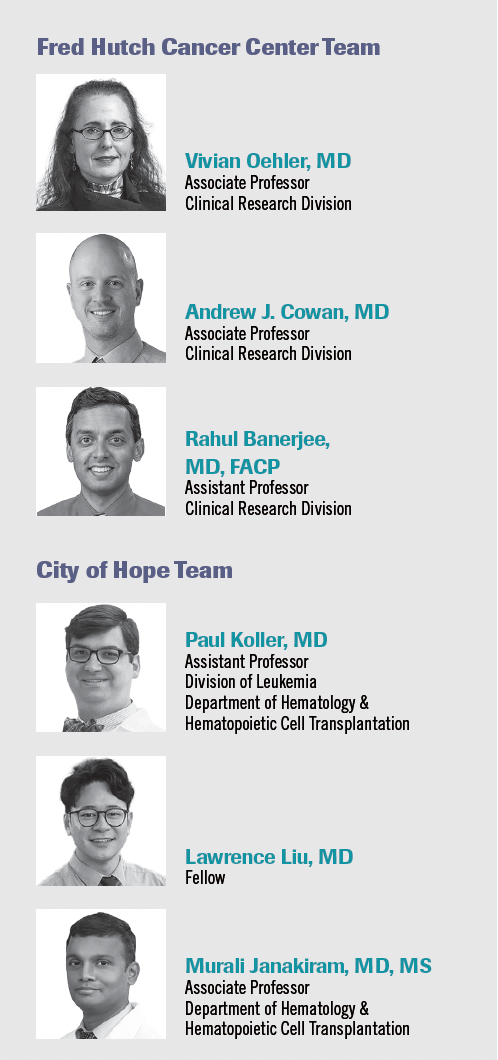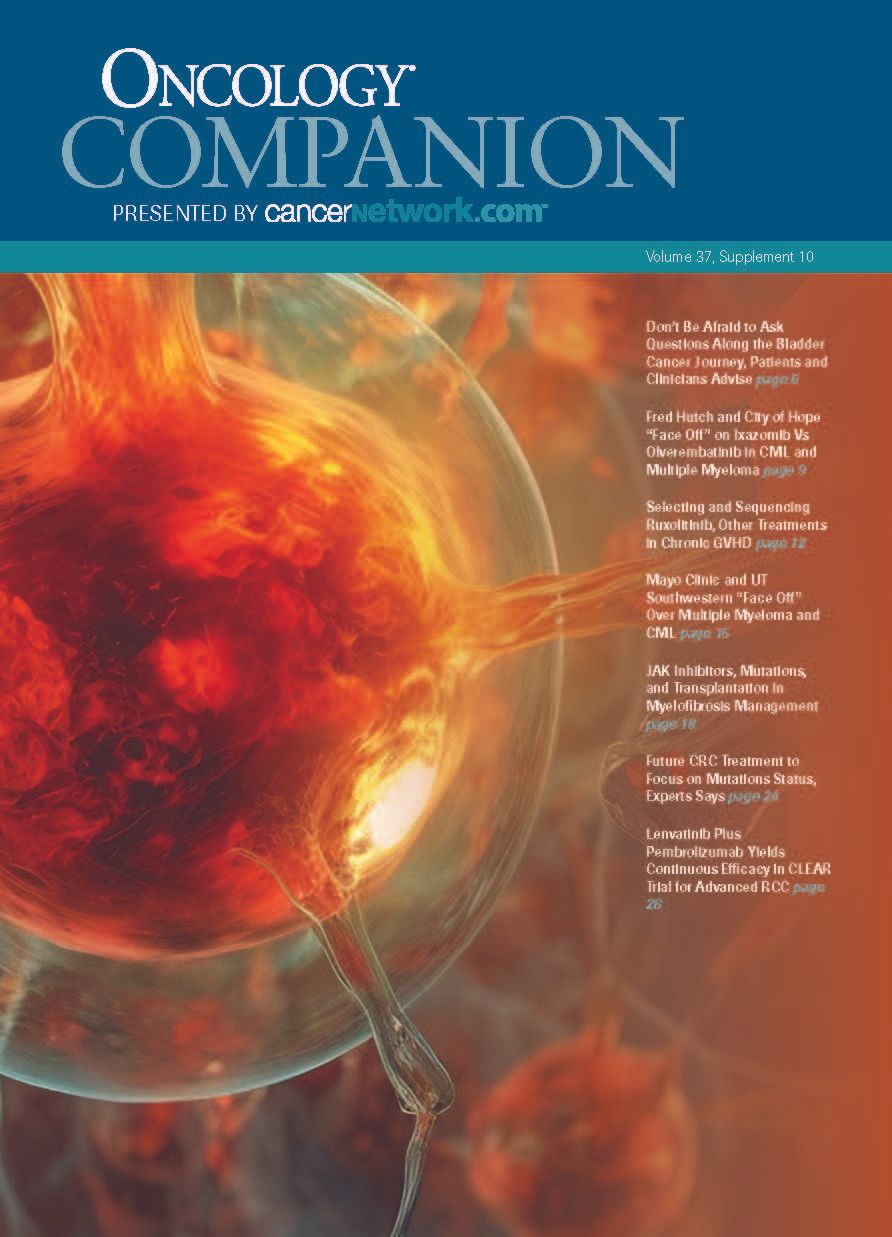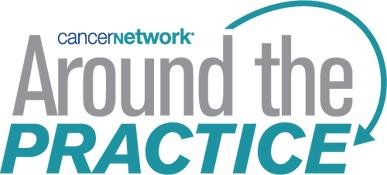Fred Hutch and City of Hope “Face Off” on Ixazomib Vs Olverembatinib in CML and Multiple Myeloma
Fred Hutch and City of Hope "Face Off" regarding presentations focusing on multiple myeloma and chronic myeloid leukemia.
During a recent Face-Off event, experts in the field of chronic myeloid leukemia (CML) and multiple myeloma from Fred Hutch Cancer Center and City of Hope gathered to discuss the use of olverembatinib and ixazomib (Ninlaro) in each respective disease state. Each institution was able to present a trial, and the opposing team was allowed to question the use of the data in a real-world application setting.
Fred Hutch and City of Hope Teams

City of Hope Presents Multiple Myeloma Data
The REMIX study (NCT03012880) assessed the combination of ixazomib plus lenalidomide (Revlimid) and dexamethasone (IXA-Rd) for patients with relapsed/refractory multiple myeloma.1 A total of 376 patients were enrolled in the study. The median age was 71 years, and 18.2% of patients had an ECOG performance status score of 2 or more. Additionally, 48.8% of patients had frailty and 62.8% had 1 existing comorbidity.
Prior to treatment, 60.4% of patients had experienced 1 line of therapy, with 60% receiving IXA-Rd as second line, 18% as third line, and 22% as fourth line and beyond. Autologous stem cell transplant (ASCT) occurred in 44.5% of patients.
A total of 340 patients received IXA-Rd at the full dose of 4 mg per day, and 36 patients were given 3 mg per day or less. Lenalidomide was given starting at 25 mg in 61.3% of patients,20 mg in 4%, 10 mg in 16.9%, and less than 10 mg in 17.7%. Dexamethasone was given at 40 mg in 52.7% of patients or 20 mg in 43%.
The median follow-up was 28.7 months, with 226 of 358 patients experiencing progression or dying. The progression-free survival (PFS) analysis did not include 1 patient who was lost to follow-up or 17 patients who had been assessed for disease progression but were still alive.
The median PFS was 19.1 months (95% CI, 15.9-21.5) in the overall population, and for those receiving IXA-Rd as second-line treatment, it was 21.5 months (95% CI, 19.2-24.8). Median PFS was 21.9 months (95% CI, 16.2-28.7) for those receiving IXA-Rd as third-line treatment and 5.8 months (95% CI, 4.8-9.4) for those receiving it as fourth-line treatment or beyond (P < .01).
For patients younger than 80 years, the median PFS was 19.1 months (95% CI, 15.9-21.9), whereas median PFS was 17.4 months (95% CI, 10.8-23.0) for those 80 years or older (P = .06). In patients with frailty, the median PFS was 14.6 months (95% CI, 10.8-21.3), whereas those who did not have frailty had a median PFS of 21.5 months
(95% CI, 17.0-29.1; P < .01).
If patients had prior ASCT, the median PFS was 19.8 months (95% CI, 14.3-24.8), whereas those who did not have prior ASCT had a median PFS of 17.8 months (95% CI, 14.4-21.5; P < .30). The median PFS for those with previous comorbidities was 19.5 months (95% CI, 12.8-24.0), and for those without comorbidities, it was 18.8 months
(95% CI, 15.3-21.9; P = .67).
The investigator-assessed objective response rate (ORR) was 73.1% for IXA-Rd. Complete response (CR) occurred in 14.5% of patients, very good partial response (VGPR) in 30.5%, PR in 28.1%, and stable disease in 10.6%. For those younger than 80 years, the ORR was 72.4%, and for those 80 years or older, the ORR was 76.8%. When IXA-Rd was given as second- or third-line therapy, the ORR increased to 80.3% and 70%, respectively. When given in the fourth line, ORR decreased to 54.4%. The duration of response was estimated to be 10.9 months (95% CI, 8.7-14.8). The median overall survival (OS) had not been reached at the time of the analysis.
Dose reductions occurred in 26.4% of patients on ixazomib and 34.4% on lenalidomide. Treatment suspensions occurred in 22.1% of patients on ixazomib and 21.3% on lenalidomide. Discontinuation of treatment occurred in 74.1% of patients on ixazomib and 57.3% on lenalidomide.
Adverse effects (AEs) occurred in 78.2% of patients, serious AEs (SAEs) in 54.3%, and treatment-related AEs (TRAEs) in 40.7%. The most common TRAEs included diarrhea (13.9%), thrombocytopenia (12.6%), and nausea (8.5%). The most common SAEs were thrombocytopenia (12.2%), plasma cell myeloma (9.5%), and death (7.8%).
Fred Hutch Examines City of Hope’s Data
Cowan: What is the rationale for using ixazomib over proteasome inhibitors [PIs] [such as] carfilzomib [Kyprolis] or bortezomib [Velcade] in patients who [have frailty] with multiple myeloma?
Liu: There’s so many options in multiple myeloma, which is great to cater the treatments to the patient’s needs. The fact that it’s a completely oral-based regimen adds to the convenience, especially for an older population [with more frailty]. I like that they have data on the dose reductions and treatment pauses, and it gives you security to know that there are other things you can do. In terms of the panel of [AEs], it’s also great to have another option to work with patients on this.
Janakiram: With ixazomib, the [findings from] trials [involving the drug] mostly have shown an improved PFS but not necessarily an improvement in OS, even when compared with the second-line setting. That is the difficulty in all the ixazomib trials. Thinking about this, I ask myself, “Is the drug effective?” [That] is the first question to ask.
Banerjee: Are there patients on lenalidomide or
daratumumab [Darzalex] plus lenalidomide where you would switch to IXA-Rd, or would this be for patients who are on bortezomib maintenance or no maintenance where would you use IXA-Rd as second-line therapy?
Liu: I would choose a different regimen if I’m sure that the patient [had disease] refractory to lenalidomide. If they were just exposed, the data were still solid for this regimen. Looking into the data in triplet regimens with daratumumab and carfilzomib, they do have a better efficacy profile, but the tolerability of this regimen was still good.
Fred Hutch Introduces Olverembatinib Use in CML
Olverembatinib monotherapy was used to assess tolerability and efficacy in a phase 1 trial (NCT04260022) for patients with ponatinib (Iclusig)-resistant CML and Philadelphia-positive acute lymphoblastic leukemia (ALL), and those with a T315I mutation.2
A total of 51 patients were randomly assigned 3:3:2 and received either 30 mg of olverembatinib once daily (n = 21), 40 mg of olverembatinib once daily (n = 18), and 50 mg of olverembatinib once daily (n = 10), each for 28-day cycles.
Baseline characteristics included 38 patients with CML and 13 patients with Philadelphia-positive ALL, the median age was 51 years, 54.9% of patients were male, and 80.4% were White.
The median follow-up was 9 months, and of the 23 patients who were evaluable with resistant CML, 77.8% had a complete cytogenetic response (CCyR), and 42.5% had a major molecular response (MMR). Patients who received olverembatinib at 30 mg and 40 mg every other day had similar responses.
In the instances where ponatinib failed, the CCyR was 83.3% and the MMR rate was 42.9%. For those with BCR::ABL T315I-mutant tumors, the CCyR rate was 87.5% and the MMR rate was 55.6%. In those who did not have the mutation, the rates were 70% for CCyR and 35.7% for MMR.
Of the 13 patients with Philadelphia-positive ALL who were evaluable for a response, 2 responded. The major cytogenetic response was 42.9%, the CCyR was 28.6%, and the MMR was 28.6%. Of note, there were 2 patients without a T315I mutation who received prior ponatinib.
Grade 3/4 nonhematologic AEs included increased blood creatine phosphokinase (13.5%), increased lipase (5.4%), increased alanine aminotransferase (5.4%), and increased aspartate aminotransferase levela (5.4%). Hematologic AEs that were grade 3/4 included thrombocytopenia, neutropenia, and leukopenia.
Six patients reported 8 serious AEs and they included blood creatine phosphokinase increase (n = 2), troponin I increase, obstructive pancreatitis, generalized edema, atrial fibrillation, sinus tachycardia, and neutropenia (n = 1 each). This did not lead to treatment discontinuation.
At the 40-mg level, artery occlusive events were potentially linked to 1 any-grade pectoris and 1 cardiac failure at the 50-mg level.
Treatment discontinuation from AEs occurred in 2 patients, and 1 each from thrombocytopenia and leukopenia, and worsening vascular issues, 3 for disease progression, and 6 for other causes.
Final Thoughts
With Fred Hutch having presented early data in the field of CML, City of Hope did not have many resounding questions regarding the results. The results were tallied, and the winner of the CML vs multiple myeloma Face Off was Fred Hutch Cancer Center.
References
- Macro M, Hulin C, Vincent L, et al. Real-world effectiveness of ixazomib combined with lenalidomide and dexamethasone in relapsed/refractory multiple myeloma: the REMIX study. Ann Hematol. 2023;102(8):2137-2151. doi:10.1007/s00277-023-05278-3
- Jabbour E, Koller PB, Oehler VG, et al. Olverembatinib (HQP1351) overcomes ponatinib resistance in patients with heavily pretreated/refractory chronic myeloid leukemia (CML) and Philadelphia chromosome-positive acute lymphoblastic leukemia (Ph ALL). Blood. 2022;140(suppl 1):200-202. doi:10.1182/blood-2022-162387

Newsletter
Stay up to date on recent advances in the multidisciplinary approach to cancer.









